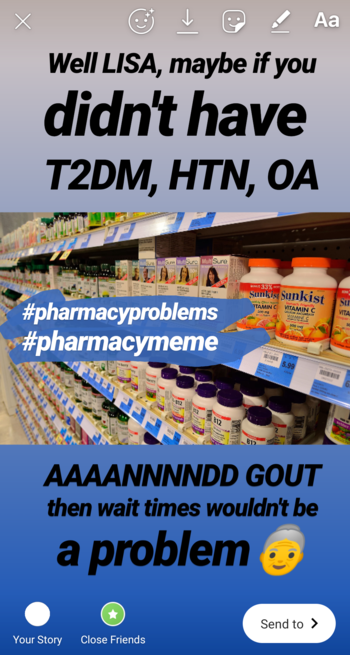Documentation:Documentation:Digital Tattoo Case Studies Project/Pharmacy/Case 2 Viral Venting
Case Study 2: Viral Venting
In groups of 3-4:
1. Read the case study and consider your response to the Essential Question(s) posed below.
2. Discuss each question below with your group, using the linked resources to support your responses.
3. Take notes on your discussion to share when the large group reconvenes.
Themes Addressed
- Permanence and public nature of the internet
- Patient confidentiality
- Raising the profile of the profession
- Group affiliation
- Interconnectedness of the pharmacy community
Learning Outcomes
By the end of this workshop and upon further reflection, students will ...
- Describe the interface between the private/public nature of online spaces
- Discuss challenges in presuming anonymity on the internet
- Illustrate the benefits and drawbacks of high-profile social media accounts dedicated to elevating the profession
Essential Question
As you read the case, consider your response to the question:
How does the term "act conscientiously" apply to digital spaces?
Case

Sarah is in her second year of the Doctor of Pharmacy (PharmD) program. For the past 2 months she has been working part-time at "Canada Plus Pharmacy" in Vancouver to help offset the high costs of being a student.
Sarah has been active on her personal social media accounts throughout her time in the pharmacy program, specifically Facebook, Snapchat, and Instagram. Since moving to Vancouver from Prince George, social media has helped her stay connected to friends and family. This has helped her feel less isolated in a new city. Since beginning the Pharmacy program, Sarah has actively ensured that all of her social media accounts are private, including Instagram, which she uses the most. As such, only her username and bio - which notes her institutional affiliation - is visible to the public.
These accounts have also allowed her to make new friends and connect to people in her program. She often responds to event invitations on Facebook, and invites classmates to study with her over Snapchat and Facebook Messenger. Additionally, during exam periods, Sarah often checks her classmates' Instagram stories to de-stress.
Because the particular "Canada Plus Pharmacy" branch Sarah works at is centrally located in Vancouver’s downtown core, it tends to be quite busy. Average wait times are approximately 15 minutes, but can often run as long as 30 minutes. Sarah typically enjoys this fast-paced environment, however the past few days have been especially busy and stressful. Sarah is also experiencing high levels of stress outside of work due to an upcoming EOB exam which she is studying for.
A patient named Mandy comes into the pharmacy rushing to pick up her medications for her type 2 diabetes, hypertension, osteoarthritis, and gout. Upon looking up Mandy’s medication profile in the pharmacy’s computer system, Sarah sees that Mandy is 71 years old.
Several patients had been waiting for their prescriptions before Mandy arrived, so Sarah gives her an approximate wait-time of 20 minutes. Mandy, irritated, comments back: “Why does it need 20 minutes, don't you just put a label on the bottle?"
Sarah calmly explains that, due to the number of patients currently waiting for prescriptions, the wait time will be a bit longer than usual. This explanation does not seem to calm Mandy, who angrily stands at the counter, glaring at Sarah and the supervising pharmacist while they work.
Sarah feels frustrated by the comment Mandy made. While she had heard remarks like this from patients in the past, she wished patients would be more understanding of the long wait times, particularly for prescription refills like Mandy’s which involve multiple medications.
While on her lunch break, Sarah takes a picture of one of the vitamin shelves at the pharmacy. She posts the image to her Instagram Story with the following text:

Sarah elected to make the post on her story rather than on her usual feed, as it will self-delete in 24 hours. She also replaced Mandy’s name with the fake name, “Lisa.”
Finding the post funny and relatable, one of Sarah’s followers, who is also a pharmacy student stressed about the upcoming EOB exam, screenshots it and forwards it to another classmate. This classmate saves it, and direct-messages it to the @pharmacymemes Instagram page, which has over 31k followers. The @pharmacymemes page posts it to their feed with a caption that credits Sarah’s username.
Sarah’s manager, Henry, is a recent graduate of the UBC PharmD Program. He has become friends with her while working together, bonding over their shared experiences in Pharmacy. While a student at UBC, Henry started following @pharmacymemes.
Shortly after Sarah's Instagram post is made, Henry comes across it while on his own Instagram account, and sees that Sarah is tagged in the post. Henry is immediately worried about his Pharmacy’s reputation, and that of himself as manager. He thinks that this does not reflect well on their organization, their patient-centred care philosophy, and violates the patient’s privacy. He is also concerned that the location of his pharmacy will be distinguishable based on the image Sarah used.
Henry confronts Sarah with these concerns. Sarah, whose post on Instagram has already been deleted (since 24 hours have passed), is unsure how to proceed. She immediately feels regretful about her actions and the position she has put Henry in. Henry saves the screenshots on file for future reference. Sarah is now stressed about how the incident may impact her professionally as she moves forward in her career. She is also unsure if she should resign from her job as a result of the incident, and realizes she will be unable to use Henry as a professional reference.
Discussion Questions
- To what extent are private social media accounts truly private? How might the digital path between Sarah's Instagram Story and the @pharmacymemes account impact her relationship with various stakeholders?
- True Privacy Online is Not Viable (News article)
- Social Media Post Prompts Firing (News Article)
- How has social media complicated the professional relationships between patients and Healthcare providers?
- Social Media in Healthcare: Privacy and Security Considerations (PDF Guideline by the Healthcare Information and Management Systems Society and Security Committee)
- Legal Frameworks eHealth - World Health Organization (Report)
- Discuss the implications of @pharmacymemes sharing Sarah's post. Did they have the right to share it? What positive and/or negative effects do pharmacy-based social media accounts, like @pharmacymemes, and hashtags like #pharmacyproblems, have on the profession?
- Can you identify any discrepancies between Henry's handling of the situation and his own online behaviour?
- @pharmacymemes (Instagram Account)
Open Access Scholarly Material
- Social Media and Gossip in the Pharmacy (Journal Article)
- The Use of Social Media in Pharmacy Practice and Education (Journal article)